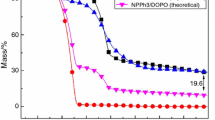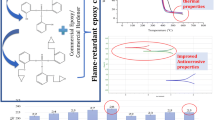Abstract
The present study attempts the synthesis of a cyclic multifunctional flame-retardant (FR) moiety from o-phenylenediamine (OPDA) as the starting material. OPDA was reacted with phenylphosphonic dichloride and further with the 3-monochloro-1,2-propanediol to obtain the final product (FRPOL) which was then incorporated into epoxy and polyurethane coating systems. The structure of the synthesized molecule was confirmed using hydroxyl value, Fourier transform infrared spectroscopy and nuclear magnetic resonance spectroscopy. The cured coating films were characterized for thermal, mechanical and flame-retardant properties. Thermogravimetric analysis and differential scanning calorimetry were used to carry out the thermal degradation studies and to know the glass transition temperatures (Tg), respectively. The thermal and mechanical properties were excellent after the incorporation of the synthesized molecule into the coating systems. The limiting oxygen index (LOI) and UL-94 vertical burning tests were carried out to check the flame retardancy of the cured coating films. The polyurethane with FR had the maximum LOI value of 32 while the epoxy with 45% concentration of FR had a maximum LOI value of 26 among all the coating formulations. The formulations with FRPOL displayed self-extinguishing behavior with no dripping in UL-94 test.
Graphic abstract

















Similar content being viewed by others
References
Vasilev K, Cavallaro A, Zilm P (2018) Special issue: antibacterial materials and coatings. Molecules 23:585. https://doi.org/10.3390/molecules23030585
Weil ED (2011) Fire sciences fire-protective and flame-retardant coatings—a state-of-the-art review. J Fire Sci. https://doi.org/10.1177/0734904110395469
Weil ED, Levchik S (2004) A review of current flame retardant systems for epoxy resins. J Fire Sci 22:25–40. https://doi.org/10.1177/0734904104038107
Pradhan S, Pandey P, Mohanty S, Nayak SK (2016) Insight on the chemistry of epoxy and its curing for coating applications: a detailed investigation and future perspectives. Polym Plast Technol Eng 55:862–877. https://doi.org/10.1080/03602559.2015.1103269
Akindoyo JO, Beg MDH, Ghazali S et al (2016) Polyurethane types, synthesis and applications-a review. RSC Adv 6:114453–114482. https://doi.org/10.1039/c6ra14525f
Noreen A, Zia KM, Zuber M et al (2016) Bio-based polyurethane: an efficient and environment friendly coating systems: a review. Prog Org Coat 91:25–32. https://doi.org/10.1016/j.porgcoat.2015.11.018
Nagy Á, Kuti R (2016) The environmental impact of plastic waste incineration. Aarms 15:231–237
Pavani P, Rajeswari TR (2014) Impact of heavy metals on environmental pollution. J Chem Pharm Sci 94:87–93
Sjostedt SJ, Abbatt JPD (2008) Release of gas-phase halogens from sodium halide substrates: heterogeneous oxidation of frozen solutions and desiccated salts by hydroxyl radicals. Environ Res Lett. https://doi.org/10.1088/1748-9326/3/4/045007
Jian R, Wang P, Xia L, Zheng X (2017) Effect of a novel P/N/S-containing reactive flame retardant on curing behavior, thermal and flame-retardant properties of epoxy resin. J Anal Appl Pyrolysis 127:360–368. https://doi.org/10.1016/j.jaap.2017.07.014
Deh S, Gähr F, Buchmeiser MR (2016) Synergistic effects in the pyrolysis of phosphorus-based flame-retardants: the role of Si- and N-based compounds. Polym Degrad Stab 130:155–164. https://doi.org/10.1016/j.polymdegradstab.2016.06.009
Schartel B (2010) Phosphorus-based flame retardancy mechanisms-old hat or a starting point for future development? Materials 3(10):4710–4745. https://doi.org/10.3390/ma3104710
Zhao X, Babu HV, Llorca J, Wang DY (2016) Impact of halogen-free flame retardant with varied phosphorus chemical surrounding on the properties of diglycidyl ether of bisphenol-A type epoxy resin: synthesis, fire behaviour, flame-retardant mechanism and mechanical properties. RSC Adv 6:59226–59236. https://doi.org/10.1039/c6ra13168a
Zhang Y, He J, Yang R (2016) The effects of phosphorus-based flame retardants and octaphenyl polyhedral oligomeric silsesquioxane on the ablative and flame-retardation properties of room temperature vulcanized silicone rubber insulating composites. Polym Degrad Stab 125:140–147. https://doi.org/10.1016/j.polymdegradstab.2015.12.007
Wang W, Wang X, Pan Y et al (2017) Synthesis of phosphorylated graphene oxide based multilayer coating: self-assembly method and application for improving the fire safety of cotton fabrics. Ind Eng Chem Res 56:6664–6670. https://doi.org/10.1021/acs.iecr.7b01293
Çakmakçı E (2017) Allylamino diphenylphosphine oxide and poss containing flame retardant photocured hybrid coatings. Prog Org Coat 105:37–47. https://doi.org/10.1016/j.porgcoat.2016.11.013
Mestry S, Kakatkar R, Mhaske ST (2019) Cardanol derived P and Si based precursors to develop flame retardant PU coating. Prog Org Coat 129:59–68
Mans V, Lugato L, Garcia D (2016) Ammonium polyphosphates and intumescent coatings in structural steel fire protection. PPCJ Polym Paint Colour J 206:23–27
Jimenez M, Duquesne S, Bourbigot S (2006) Characterization of the performance of an intumescent fire protective coating. Surf Coat Technol 201:979–987. https://doi.org/10.1016/j.surfcoat.2006.01.026
Mestry S, Mhaske ST (2019) Synthesis of epoxy resins using phosphorus-based precursors for flame-retardant coating. J Coat Technol Res. https://doi.org/10.1007/s11998-018-00157-3
Park H-S, Kwon S-Y, Seo K-J et al (1999) Preparation and physical properties of polyurethane flame retardant coatings using phosphorus-containing lactone modified polyesters. J Coat Technol 71:59–65. https://doi.org/10.1007/BF02697979
Liu C, Li T, Zhang J et al (2016) Preparation and properties of phosphorous-nitrogen containing UV-curable polymeric coatings based on thiol-ene click reaction. Prog Org Coat 90:21–27. https://doi.org/10.1016/j.porgcoat.2015.09.004
Mestry SU, Patil DM, Mhaske ST (2018) Effect of 2-aminobenzothiazole on antimicrobial activity of waterborne polyurethane dispersions (WPUDs). Polym Bull. https://doi.org/10.1007/s00289-018-2469-9
Sonnier R, Dumazert L, Livi S et al (2016) Flame retardancy of phosphorus-containing ionic liquid based epoxy networks. Polym Degrad Stab 134:186–193. https://doi.org/10.1016/j.polymdegradstab.2016.10.009
Jeng RJ, Shau SM, Lin JJ et al (2002) Flame retardant epoxy polymers based on all phosphorus-containing components. Eur Polym J 38:683–693. https://doi.org/10.1016/S0014-3057(01)00246-4
Wang S, Xu C, Liu Y et al (2017) Vanillin-derived high-performance flame retardant epoxy resins: facile synthesis and properties. Macromolecules 50(5):1892–1901. https://doi.org/10.1021/acs.macromol.7b00097
Chen X, Jiao C (2008) Thermal degradation characteristics of a novel flame retardant coating using TG-IR technique. Polym Degrad Stab 93:2222–2225. https://doi.org/10.1016/j.polymdegradstab.2008.09.005
Qian LJ, Ye LJ, Xu GZ et al (2011) The non-halogen flame retardant epoxy resin based on a novel compound with phosphaphenanthrene and cyclotriphosphazene double functional groups. Polym Degrad Stab 96:1118–1124. https://doi.org/10.1016/j.polymdegradstab.2011.03.001
Wu CS, Liu YL, Chiu YS (2002) Epoxy resins possessing flame retardant elements from silicon incorporated epoxy compounds cured with phosphorus or nitrogen containing curing agents. Polymer (Guildf) 43:4277–4284. https://doi.org/10.1016/S0032-3861(02)00234-3
Yang S, Hu Y, Zhang Q (2019) Synthesis of a phosphorus–nitrogen-containing flame retardant and its application in epoxy resin. High Perform Polym 31:186–196. https://doi.org/10.1177/0954008318756496
Elwan I, Jabra R (2017) Preparation and evaluation of mechanical and physical properties of random silica fiber/modified resole resin composites. J Mater Environ Sci 8:1220–1234
Changkun L, Hongliang Z (2017) Patent number WO2017193463A1
Choudhury A (2018) Advances in halogen-free flame retardants. Trends Text Fash Design 1(4):70–74. https://doi.org/10.32474/LTTFD.2018.01.000117
Author information
Authors and Affiliations
Corresponding author
Additional information
Publisher's Note
Springer Nature remains neutral with regard to jurisdictional claims in published maps and institutional affiliations.
Electronic supplementary material
Below is the link to the electronic supplementary material.
Rights and permissions
About this article
Cite this article
Arora, S., Mestry, S., Naik, D. et al. o-Phenylenediamine-derived phosphorus-based cyclic flame retardant for epoxy and polyurethane systems. Polym. Bull. 77, 3185–3205 (2020). https://doi.org/10.1007/s00289-019-02910-z
Received:
Revised:
Accepted:
Published:
Issue Date:
DOI: https://doi.org/10.1007/s00289-019-02910-z




